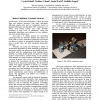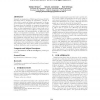20 search results - page 3 / 4 » Integrating individual and social intelligence into module-b... |
AAAI
2006
13 years 6 months ago
2006
hibition: Extended Abstract Social insects, such as ants and termites, collectively build large and complex structures, with many individuals following simple rules and no centrali...
ATAL
2007
Springer
13 years 11 months ago
2007
Springer
Research on organization of Multi-Agent Systems (M.A.S.) has shown that by adapting its organization, a M.A.S. is better able to operate in dynamic environments. In this paper we ...
ATAL
2004
Springer
13 years 10 months ago
2004
Springer
We present a domain model and protocol for the exchange of recommendations by selfish agents without the aid of any centralized control. Our model captures a subset of the realiti...
ECAL
2007
Springer
13 years 11 months ago
2007
Springer
Agency detection is studied in a simple simulated model with embodied agents. Psychological experiments such as double TV-monitor experiments and perceptual crossing show the centr...
ESAW
2006
Springer
13 years 8 months ago
2006
Springer
The use of norms is a well-known technique of co-ordination in multi-agent systems (MAS) adopted from human societies. A normative position is the "social burden" associa...


